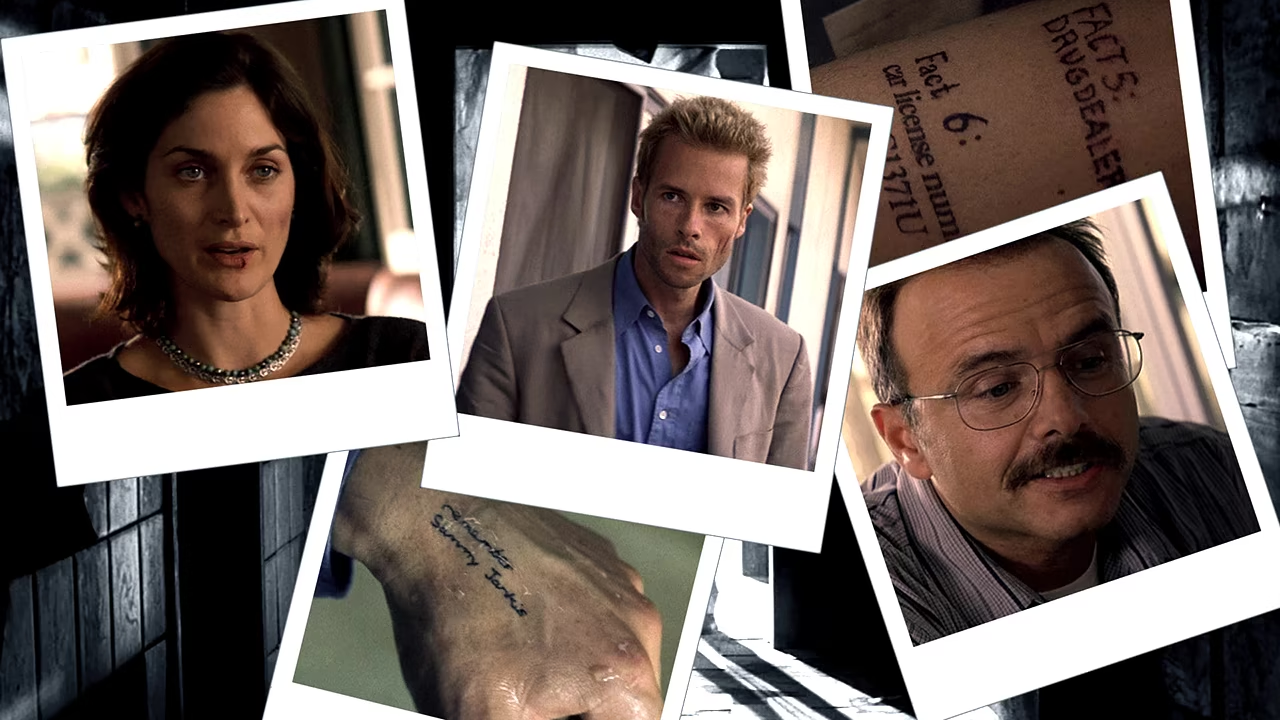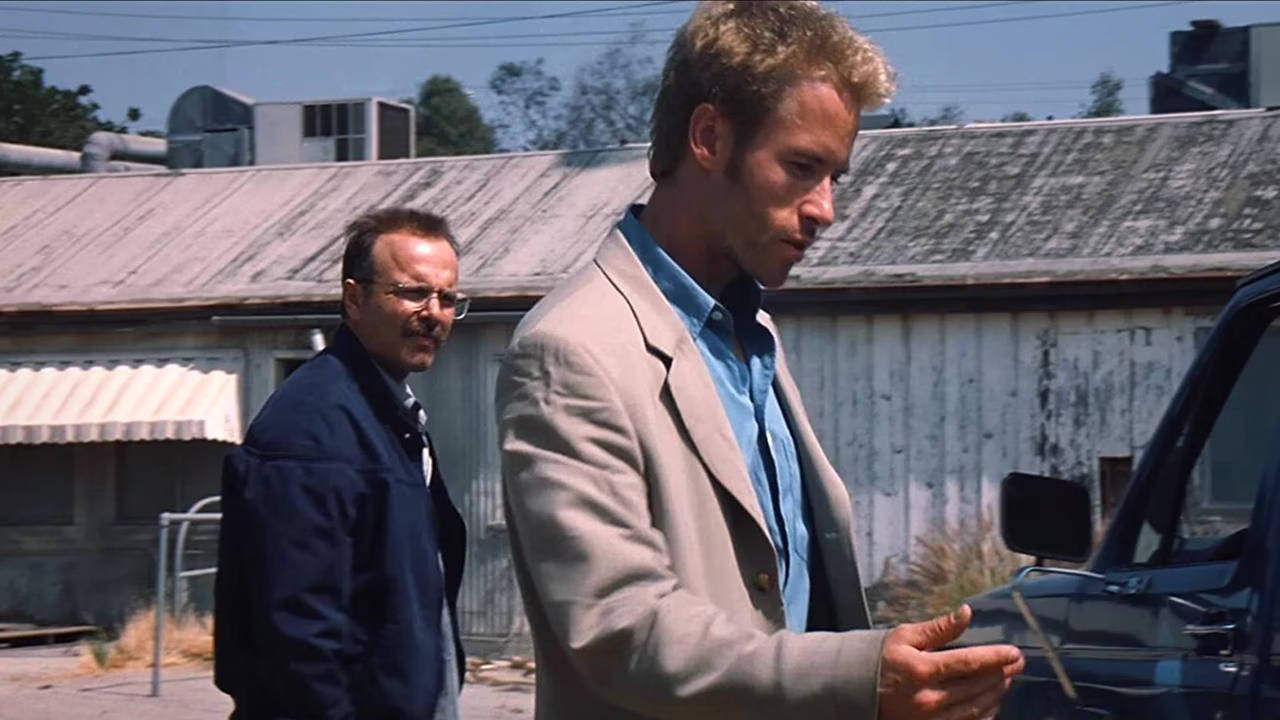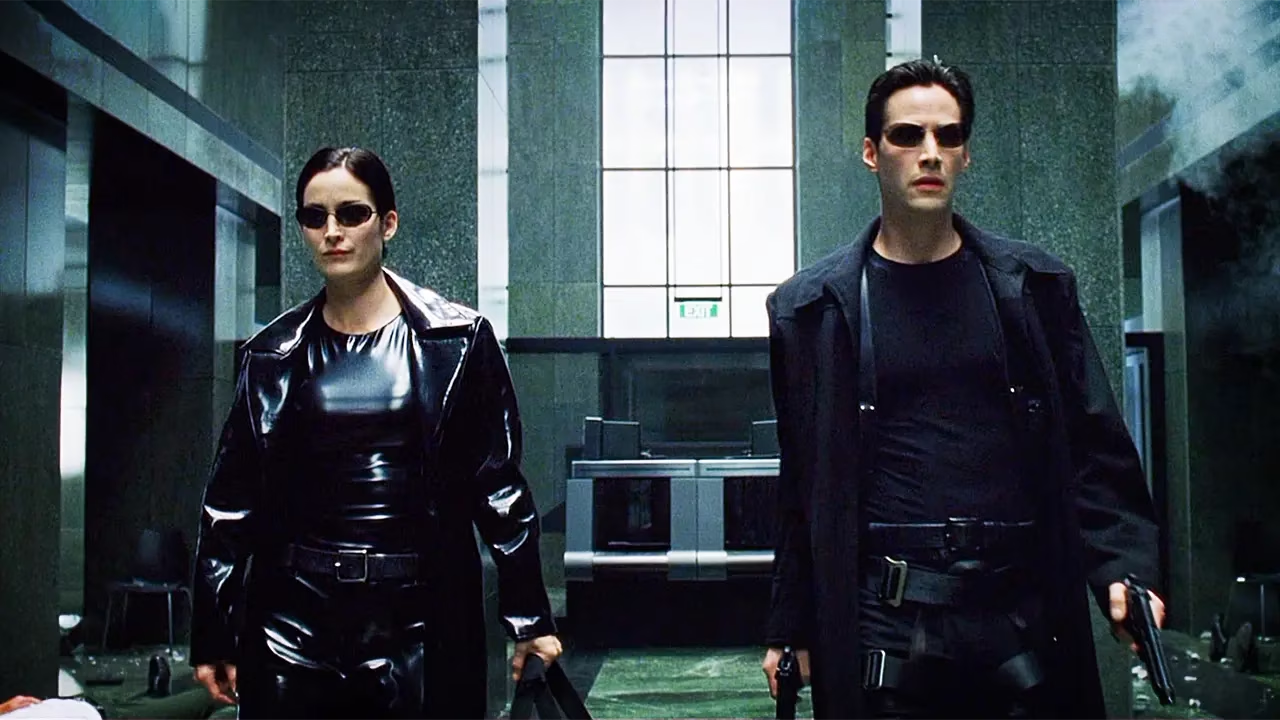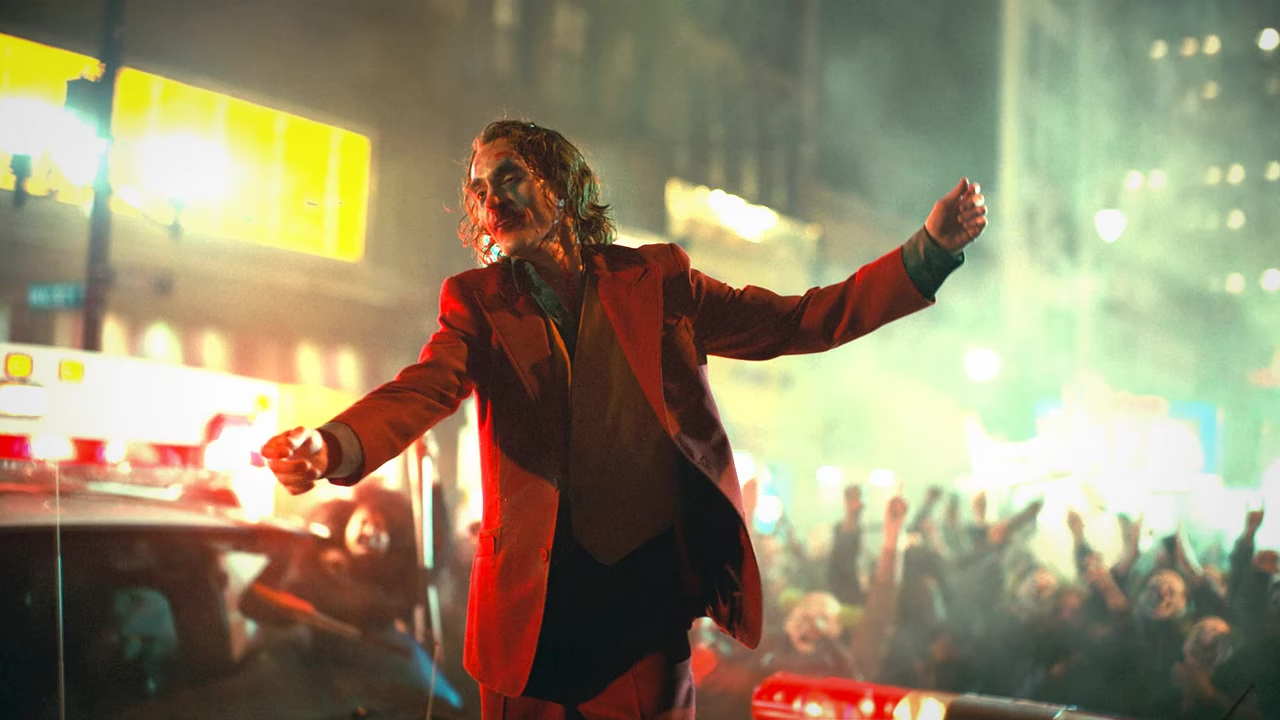
Christopher Nolan’s groundbreaking psychological thriller Memento (2000) revolutionized cinematic storytelling through its innovative exploration of memory, identity, and truth. The film’s reverse-chronological structure, which mirrors its protagonist’s anterograde amnesia, transformed what could have been a conventional revenge narrative into a profound meditation on the nature of consciousness and personal identity. By manipulating time and perspective, Nolan created a viewing experience that forces audiences to inhabit the fractured mental state of its main character, Leonard Shelby.
At its core, the film grapples with fundamental questions about the reliability of memory and its role in shaping human identity. Drawing inspiration from philosopher John Locke’s theories on consciousness and personal identity, Memento presents memory not as a faithful record but as an interpretive process, easily manipulated and inherently unreliable. Through Leonard’s desperate attempt to maintain a sense of purpose through his elaborate system of notes, photographs, and tattoos, the film explores how humans construct meaning in the face of uncertainty, and how the stories we tell ourselves—whether true or false—become the foundation of our identity.
Fractured Mind, Vengeance System
Memento begins with a striking reverse sequence. Leonard Shelby (Guy Pearce) snaps a Polaroid of a dead man and watches as the image fades back into the camera. The victim is Teddy (Joe Pantoliano), whom Leonard has just killed because he believes he is responsible for the murder of Leonard’s wife, Catherine (Jorja Fox). This jarring moment immediately draws viewers into the film’s unconventional timeline.
The film employs a dual-timeline structure: color sequences move backward in time, showing events in reverse order, while black-and-white scenes progress forward chronologically. These two timelines eventually converge at a crucial turning point, providing context for each other and creating a complete narrative. In the first black-and-white sequence, Leonard sits in a motel room and speaks to an unknown caller. He carefully explains the systems he has developed to cope with his anterograde amnesia, a condition that prevents him from forming new memories after a violent home invasion that resulted in his wife’s death.
This invasion serves as the emotional catalyst driving Leonard’s quest. While investigating suspicious noises, Leonard discovered two intruders attacking his wife. In the struggle that followed, Leonard managed to shoot one assailant, but a second attacker emerged from behind, struck him on the head, and left him unconscious beside his dying wife. These final moments before his memory impairment became permanently etched in his mind.
When authorities dismissed the possibility of a second attacker, Leonard took justice into his own hands. He would later encounter Teddy, who sometimes identifies himself as Officer John Gammell, who claims to be helping Leonard find his wife’s killer. Leonard created an elaborate system of Polaroid photographs with handwritten notes, tattooed key facts across his body, and established rituals to maintain continuity in his fragmented existence. This methodical approach fuels his single-minded mission: finding and killing “John G.,” the man he believes murdered his wife.

This system relies heavily on detailed documentation. Leonard uses notepaper for temporary notes, later transferring critical information to more permanent forms. He employs a Polaroid camera for instant visual cues of people and places—“So you know who you’re dealing with”—and most notably, uses permanent tattoos for facts he considers unchanging, such as “JOHN G. RAPED AND MURDERED MY WIFE,” “FIND HIM AND KILL HIM,” and various gathered clues. This meticulous recording of every key detail before it fades serves as his constant, self-chosen set of reminders in his ever-resetting world.
This elaborate system represents Leonard’s attempt to create an objective external memory, a substitute for his damaged internal processes. Without the ability to trust his own mind, he builds what he believes is a foolproof method for navigating reality and maintaining his sense of purpose, which is intrinsically tied to his mission of revenge. The physical nature of his documentation—especially the permanence of his tattoos—gives him an illusion of certainty and control in a world that constantly slips away from his grasp.
Sammy Jankis’s Tragic Narrative
In a black-and-white sequence, Leonard recounts a story from his previous career as an insurance investigator involving a claimant named Sammy Jankis (Stephen Tobolowsky). Sammy claimed he was unable to form new memories after a car accident. Leonard explains that he tested Sammy based on the understanding that individuals with anterograde amnesia can often still learn through conditioning (implicit memory), even if they don’t recall the learning process itself.
However, according to Leonard’s account, Sammy repeatedly failed these conditioning tests—for instance, he did not learn to avoid electrified objects despite repeated exposure. Because Sammy did not demonstrate this unconscious learning, Leonard concluded that Sammy’s condition was not physical but psychological (or that Sammy was faking his amnesia), leading him to deny the insurance claim. This conclusion, and indeed the entire story Leonard tells about Sammy, is later cast into doubt, raising questions about Leonard’s reliability as a narrator.
Sammy’s narrative, as Leonard tells it, takes a devastating turn through the actions of Sammy’s diabetic wife (Harriet Sansom Harris). Struggling to accept the legitimacy of her husband’s condition and desperate for proof, she devised a tragic experiment to test whether his memory loss was genuine. She repeatedly asked Sammy to administer her insulin injections, minutes apart, claiming each time that it was time for her shot. Each time, with no recollection of previous injections, Sammy complied, believing it was the appropriate time for her medication.
This “test” ended in tragedy with her death from insulin overdose. According to Leonard’s account, Sammy remained unaware of his role in the tragedy, unable to comprehend what he had done, and was eventually institutionalized. However, in a brief but critical moment in the film, we see Leonard himself in the institution instead of Sammy—a visual clue suggesting Leonard might be projecting his own experiences onto Sammy’s story, casting doubt on the reliability of this entire narrative.
Unveiling Truths, Creating Purpose

Explore More:
The narrative shifts to the color sequences, which move backward in time. In these scenes, we are introduced to Teddy (Joe Pantoliano), an associate who appears to be helping Leonard. Although Teddy occasionally claims to be a police officer, he is actually an undercover or corrupt officer named John Gammell. He offers to assist Leonard in tracking down a man named John G., which eventually leads them to Jimmy Grantz (Larry Holden), a drug dealer whom Teddy identifies as the person Leonard is seeking.
Their collaboration reaches a turning point at an abandoned building, where Leonard confronts and kills Jimmy. He documents the aftermath using his Polaroid camera, reinforcing his system for remembering events. As Jimmy dies, he unexpectedly utters the name “Sammy,” a puzzling moment that hints at a deeper connection between their stories. This clue is one of several subtle signs that suggest Leonard’s understanding of the situation may be incomplete or distorted.
Immediately after Jimmy’s death, Teddy arrives at the abandoned building and confronts Leonard about what he’s done. Now dressed in Jimmy’s expensive suit and driving his Jaguar, Leonard listens as Teddy reveals a series of shocking truths. He tells Leonard that the man responsible for his wife’s rape and the original attack had already been found and killed over a year ago. According to Teddy, Leonard had successfully completed his mission with Teddy’s help, and they even took a photograph to commemorate the moment. These revelations raise serious doubts about Leonard’s true motivations and his ability to trust his own memory.
Teddy later claims that the story of Sammy Jankis is largely a confabulation. This type of memory distortion occurs when gaps in memory are unconsciously filled with false or misinterpreted details. According to Teddy, Leonard has unknowingly reconstructed parts of his own history and projected them onto a fictional character to cope with unbearable truths. While Sammy was indeed a real person and a fraud investigated by Leonard, Teddy insists that the tragic elements involving a diabetic wife and an insulin overdose were not Sammy’s but Leonard’s.
According to Teddy’s revelation, Leonard’s wife actually survived the initial assault. Teddy then suggests that the tragic elements involving a diabetic wife dying from an insulin overdose—which Leonard had attributed to Sammy Jankis’s story—were actually from Leonard’s own life. Teddy claims Leonard’s wife died because Leonard himself accidentally administered too much insulin, though the film deliberately maintains ambiguity about whether this revelation is trustworthy.
The implications of this revelation are profound. Teddy’s account suggests that Leonard’s pursuit of justice is actually driven by a deeply buried need to avoid confronting his own responsibility and emotional pain. Leonard, in his damaged state, appears to have invented a reality where his guilt is externalized and made manageable through continuous vengeance. This coping mechanism allows him to maintain a sense of identity and purpose, even as he unknowingly repeats the same cycle.
Shaken by what he has learned and sensing that Teddy is taking advantage of his condition, Leonard makes a drastic decision. He begins to selectively alter his recorded reality by burning photographs that served as his external memory. This includes the image of Jimmy, the man he just killed, and the earlier photo Teddy had taken of him celebrating a previous act of vengeance. These actions represent Leonard’s attempt to erase conflicting truths and rewrite his own narrative once more, effectively manipulating his system rather than destroying it entirely as he immediately proceeds to create new “facts” within it.
In what may be the film’s most morally complex moment, Leonard chooses to manipulate his future self. Confronted with Teddy’s potentially truthful revelations—which would deprive him of his purpose and identity as an avenger—Leonard deliberately creates a new mission by setting up Teddy as the next target. He consciously chooses the comforting lie of ongoing vengeance over a potentially devastating truth. By doing this, Leonard gives his life a renewed sense of meaning, even though it is based on deception. He no longer passively suffers from his condition but instead uses it to construct a personal myth that sustains him.
Leonard’s final monologue highlights his need to believe in a world that exists beyond his broken memory. He reflects on the nature of reality and identity, asking whether the world continues to exist when his eyes are closed and whether his actions still have meaning. He concludes that belief in an external reality is necessary. “We all need mirrors to remind ourselves who we are,” he says. “I’m no different.” In this statement, Leonard affirms his need to shape a reality that he can live with, even if that reality is built on selective memory and self-deception.
Natalie’s Deception, Cycle Completes
After killing Jimmy and taking a Polaroid of him, Leonard discovers a key chain and a note in Jimmy’s clothes with an address and a name: Natalie. This discovery leads him to Natalie (Carrie-Anne Moss), Jimmy’s girlfriend and a bartender. When Leonard shows up driving Jimmy’s car and wearing his clothes, Natalie is understandably alarmed and suspicious. When she questions Jimmy’s whereabouts, Leonard’s memory resets, leaving him unable to explain the situation coherently.
To test the severity and nature of Leonard’s memory loss, Natalie devises a disturbing experiment. Natalie first provokes Leonard by insulting his wife and condition, then leaves before his memory resets. When she returns after his memory has reset and he no longer remembers her provocation, she has various people in the bar spit into a glass of beer before serving it to the unwitting Leonard. This cruel test confirms to Natalie both the authenticity and vulnerability of his condition.

As Natalie realizes Leonard likely killed Jimmy, she spots an opportunity and decides to use his condition to her advantage, driven by her own grief, fear, and desire for revenge against another associate, Dodd. Rather than turning him in to the authorities, she enlists his help in dealing with Dodd (Callum Keith Rennie), a threatening figure demanding money he believes Jimmy owed. Leonard, swayed by Natalie’s manipulative appeal to his protective instincts (by showing him feigned injuries she implies Dodd inflicted) and his deep-seated need for purpose, agrees to help, though his memory reset means he won’t consciously remember making this promise or why he’s targeting Dodd.
The confrontation with Dodd unfolds with darkly comedic elements as Leonard, in the midst of being chased, forgets why he is being pursued and who Dodd is. During a temporary escape, he even takes a shower while supposedly hiding. Despite this memory lapse, Leonard, guided by his notes and instincts, ultimately subdues Dodd, ties him up in a closet, and takes a Polaroid. In a final ironic twist illustrating his condition, he must ask his defeated opponent’s name and check his notes to understand their conflict, before deciding to call Teddy for assistance, believing him to be a helpful police contact.
In a pivotal act of manipulation, Natalie provides Leonard with a DMV printout for John Edward Gammell (Teddy), containing his physical description and license plate number. While Natalie’s primary aim is to use Leonard to handle Dodd, and she doesn’t explicitly ask Leonard to kill Teddy, this information becomes instrumental. Later, after Teddy’s unsettling revelations, Leonard consciously chooses to manipulate his own memory system. He writes “DON’T BELIEVE HIS LIES” on Teddy’s photograph and records Teddy’s license plate number from the DMV printout as a key clue for a new tattoo.
This act effectively sets Teddy up as his next “John G.” After verifying the license plate matches Teddy’s car, Leonard departs with a renewed, fabricated sense of purpose, his mind clinging to his self-imposed clues. He trusts his notes and tattoos, unaware they serve a manipulated narrative. Natalie, watching silently, witnesses her subtle orchestration succeed. Her actions, not explicitly aimed at Teddy’s death, steer Leonard’s fragmented reality toward tragedy, significantly contributing to Teddy’s demise.
The story reaches its emotional and narrative climax at an abandoned building-the same location where Jimmy Grantz was killed and where Leonard believes his original revenge killing took place. This building (distinct from the Discount Inn motel where Leonard temporarily resides) features in his recurring and confused memories, sometimes intertwined with aspects of the Sammy Jankis story. Leonard arrives there believing he has finally found the man responsible for his suffering. He is driven by the evidence Natalie provided, along with his own tattooed notes and emotional certainty. He lures Teddy to the building and kills him, convinced that justice has been served.
After the act, Leonard takes a Polaroid photo of Teddy’s body. This is the same image we see developing and fading in the film’s opening scene. With Teddy’s death, the film’s opening scene aligns with the chronological end of the events depicted in the color sequences. This convergence brings the two timelines together, showcasing how Leonard willfully perpetuates his cycle of revenge. This intricate loop prompts the audience to question the relationship between truth, memory, and identity. As Leonard constructs his own version of reality, the film challenges viewers to consider how memory shapes meaning and whether any version of the truth can be trusted when the mind is working so hard to create its own.








